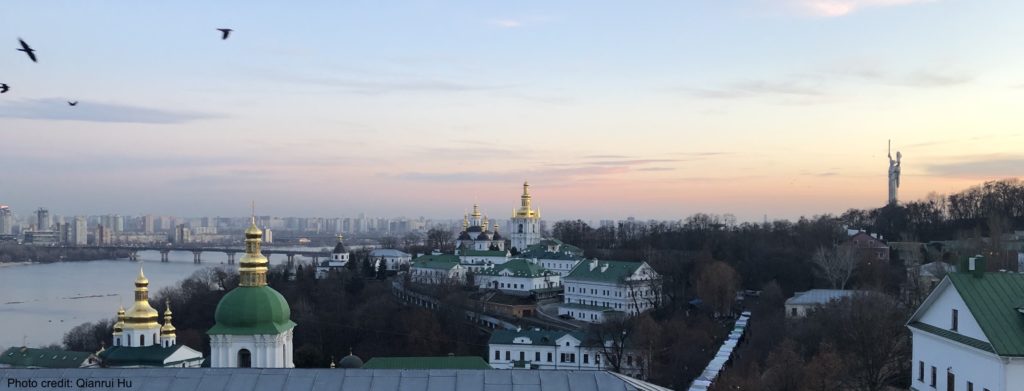
Qianrui Hu
‘Civil wars are social processes involving various forms of agency. This approach requires us to explore socialisation between actors and try to understand interactive mechanisms between them – rather than simple causal determinants…‘
Identity is often one of the central foci of conflict. Not only may it contribute to conflict onset, as in Abkhazia. But it may also impact on post-war legacies: affecting reconciliation and reconstruction, political participation, the economy, and education. Hence, understanding the dynamics of identity in a conflict setting is crucial. However, identity is a fluid and fluctuating concept, which needs to be contextualised and treated with extensive local knowledge.
In this blog, I explore the Ukrainian case: discussing why common identity categories, such as ethnicity or nationality, do not capture the complex reality of fluctuating identities in this specific context and suggesting some methodological implications regarding how to grasp the scope, contextuality, and interconnectedness of ‘identity’.
Ethnicity and Nationality in the Soviet Union and Post-Soviet Ukraine
To understand the nuances of ethnicity and nationality in Ukraine, one must pay heed to common Soviet practices of nationality. The fifteen Soviet republics were largely organised along ethnic lines: operationalised around a primordial understanding of ethnicity, capturing language, religion, or culture. These quasi-nation states had their own territories, administrative, and cultural institutions – and developed their own national languages, as well as their own national intelligentsias. In line with Leninist ideology on ethnic diversity, the Soviet state adopted the ‘Korenizatsiya’ (rooting) policy in the 1920s to harmonise the relationship between central state and ‘national peripheries’ comprising parts of the Russian Empire. However, under Stalin, Korenizatsiya was increasingly replaced by nationality as a tool for regulating relations between central state and different groups of people. Under this transition, the state began documenting ‘natsionalnost’ (a Russian word meaning ethnicity): including the category, for example, in Soviet citizens’ internal passports – and thus clarifying the boundaries between various ethnic groups. One’s ‘natsionalnost’ was not ‘chosen’; but, rather, inherited from one’s parents. In this way, territorial nationhood and ethnic nationality were institutionalised as basic social categories across the Soviet Union.
From the time of Khrushchev, the Soviet Union adopted a series of policies seeking to ‘mix’ ethnic groups (for various reasons, including assisting industrialisation and urbanisation). During this period, individuals were resettled across the Union to take on new jobs; many people moved to other republics; and communities intermingled through inter-ethnic marriages. The imagined boundaries between different republics existed mainly on maps, and individuals travelled freely across ‘borders’. Simultaneously, the Russian language was advanced as the language for inter-ethnic communication. People began identifying themselves within a wider context than their home republic, at least in principle: marking the birth of the ‘Soviet person’. This new ethnopolitical community was legalised by the 1977 Soviet Constitution, albeit with other supra-ethnic identities persisting on passport documentation.
The English terms ‘ethnicity’ and ‘nationality’ do not have a perfect equivalent in Russian or Ukrainian. The most commonly used word in Ukraine, ’natsionalnist’, the equivalent of Russian ‘natsionalnost’, straddles both ‘ethnicity’ and ‘nationality’: conveying simultaneous ethnocultural and political meanings. Later, such sociolinguistic nuance made it difficult for newly independent Ukraine to document ethnicities in state censuses. Census designers finally settled on ‘native language’ as an official ethnic identifier, signifying primordial ‘roots’ rather than ‘language of everyday use’ as the source of identity. Russian-speaking Ukrainians, who may not speak the Ukrainian language fluently/regularly, can still claim ‘Ukrainian’ ethnicity (rather than ‘Russian’ ethnicity) in recognition of their linguistic ‘roots’, if not their present linguistic practice. Modern Ukrainian identity is therefore a complicated and nuanced matter – with roots in a genealogy of interpretations as to what it meant to be ‘Soviet’, ‘Ukrainian’, or ‘Russian’.

Regional histories
The war in Ukraine, begun eight years ago in East Ukraine, also has a regional dimension. Scholars tend to refrain from calling the war in Donbas a civil war, and I do not suggest regional factors led to the outbreak of war. Nevertheless, common stereotypes regarding the Donbas region have become part of the Putin regime’s justification of the present war in Ukraine. The most important thing to note here is that Donbas is an integral part of Ukrainian ethnographic territory but became highly Russified over time. During the period of the Russian Empire, it was part of the administrative unit Novorossia (‘New Russia’). Moreover, during the early Soviet era, a short-lived republic was established in Donbas and surrounding regions in opposition to the Kyiv-based Ukrainian People’s Republic; since Soviet administrators were against all forms of Ukrainian nationalism. WWII also left a specific imprint on Donbas – as regards an historical memory of Soviet fighters’ heroism. Post-war industrialisation and urbanisation brought a massive influx of migrants, particularly Russians, to the region, and Donbas became an exemplar for Khrushchev’s nationality ‘mixing’ policy: with recorded rates of inter-ethnic marriage reaching 55% in the 1970s. Donbas’ industrial output was once so high that the region earned the slogan ‘Donbas fed the whole USSR’; and, after 1991, ‘Donbas fed the whole Ukraine’. Such slogans have effectively constructed an identity of ‘imagined economy’ in the region.
The Putin regime claims Donbas is part of the ‘Russian world’: using this claim to legitimise a full-scale war to ‘demilitarise and de-Nazify’ Ukraine, and protect Russian-speaking people. The complex history of Soviet, Ukrainian, and Donbas ‘identities’ traced above reveals the superficiality of such a claim, however. Identities in the post-Soviet world generally, and in Donbas specifically, are complex – per a recent interview with an individual from Donbas, reflecting on their personal identity: ‘I don’t know, they actually don’t record it anymore. My Dad’s Ukrainian, Mum’s Russian, I don’t know how I should combine it. I speak both Ukrainian and Russian language’.
War as a Catalyst for Identity Shift
War is a powerful catalyst for identity formation. In hybrid warfare (by which I mean conflict involving both military and non-military strategies, such as information warfare), individuals are not only physically involved in war; they are also stuck between opposing discursive borders.
Previous research on identity shift in Ukraine has paid attention to the changing meanings of social categories – be they ethnic, linguistic, or national identities, such as ‘Russian-speaking Ukrainian’, ‘Ukrainian citizen’, or ‘Ethnocultural Ukrainian’. Scholars have undertaken remarkably complex research designs and conducted plentiful sociological surveys to capture a general trend of identity shift after the outbreak of war in 2014. Researchers hypothesise a growing civic identity in Ukraine since 2014, as the war united communities (including against an aggressive external government). But what are the criteria for civic identity in the Ukrainian context? As discussed above, the very subtle category of ‘natsionalnist’ still causes conceptual problems for researchers. ‘Natsionalnist’ does indeed represent a category of ethnocultural identity for some researchers. But, for others, it suggests a measure of civic identity. This conceptual inconsistency suggests we may need an alternative signifier, or research design, to capture Ukrainian civic identity’s heterogeneous dimensions.
There are many actors, contexts, and nuances to take into consideration when it comes to the concept of ‘identity’ in war. Civil wars (or indeed inter-state wars like the present war in Ukraine) are, as the Civil War Paths project suggests, social processes involving various forms of agency. This approach requires us to explore socialisation between actors and try to understand interactive mechanisms between them – rather than simple causal determinants alone. Ethnicity surveys do not capture all the nuances of individual identity, manifesting instead group categories as they apply to an individual in a specific temporal moment and spatial contingency. What other method(s) could we develop to combine examination of personal identity (built through personal experiences) and social identity (lying at the intersection of various social categories, including ethnicity, nationality, gender, etc.)?
Narrative Political Identity, discussed by Wendy Pearlman in her research on narratives of fear in Syria, is a promising method here. Borrowing from social psychology, this method traces individuals’ personal stories, which are full of rich context and contingencies: and examines the impacts of different political events for the participant. Ukraine would be a particularly suitable case to explore this method’s usefulness. Since 2014, war-related displacement and the establishment of the two self-proclaimed people’s republics have led to the dispersal of people across four political entities: Ukraine, Russia, and the de-facto states. Different discourses within the information war are now in play: actively constituting social reality in these entities. However, the complexity of dual nationality in Donbas acts as a bridge linking these opposing discourses and emergent categories: creating a fruitful research context, in which to examine when different forms of identity (‘Russianness’ or ‘Ukrainianness’) matter.
Dual nationals in Donbas often enjoy family ties in Russia – where many Donbas Ukrainians have fled to escape war since 2014. We could develop a better understanding of how war (and understandings of it) overlaps with identity formation by listening to the identity stories of individuals who have found their lives disrupted by it. This means paying attention to personal experiences of war, and to individual interactions with family/other social ties. It also means thinking of identity not only as a precipitator of conflict, but also as a fluid phenomenon – whose salience varies over time, in unpredictable ways, and in response to personal circumstances. This kind of research, uncovering connections between ‘Russianness’ and ‘Ukrainianness’ in relation to temporal and spatial contingency, would therefore contribute to a heightened appreciation of the concept of ‘identity’ – which could apply to conflict studies generally.

